
The
Victor-Victrola Page
How can I tell if my Victor or Victrola is a
fake? How can I tell if it is original or has been restored?
ANSWER:
Forgeries of external horn
phonographs (e.g. Victors) are rampant on Ebay, at some antique stores and at flea markets. These
can usually be spotted a mile away by any serious collector; the horns are
often made of stamped tin and plated in a cheap-looking brass or gold, and
the angle of the horn is usually too
high. There is often a pattern or design embossed in the horn. A sharp angle
at the horn "elbow" (the area at the base of the horn) is a dead-giveaway.
Victor's elbows always were formed with a gradual (smooth) rounded
transition, not a sharp, sudden corner.
Most fakes are made in
India or China, some using all-new parts and some with a mish-mash assembly of old and new parts. Before a novice buyer purchases
an external horn phonograph, an expert should be consulted to provide an
assessment of the machine in question, as there are many good-looking fakes on the market
today. 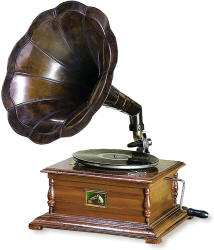 Some
of the reproductions can look pretty impressive (picture on left); others
are artificially "aged" to look old and can be quite convincing. When the
builder uses components (e.g. cabinets and/or horns) from a actual antique
phonograph, and assembles them using newer motors and hardware parts, it can
be difficult for the non-expert buyer to determine authenticity.
Reproduction or "fake antique" machines have a nominal value of about
$100.00 at resale today, mostly as decorations or movie props. In most
cases, repair services and motor rebuilders won't touch them, as the parts
are often impossible to find, and are often "jury-rigged" together to make
the motor functional. So it it quits working, you are probably out of luck.
Some
of the reproductions can look pretty impressive (picture on left); others
are artificially "aged" to look old and can be quite convincing. When the
builder uses components (e.g. cabinets and/or horns) from a actual antique
phonograph, and assembles them using newer motors and hardware parts, it can
be difficult for the non-expert buyer to determine authenticity.
Reproduction or "fake antique" machines have a nominal value of about
$100.00 at resale today, mostly as decorations or movie props. In most
cases, repair services and motor rebuilders won't touch them, as the parts
are often impossible to find, and are often "jury-rigged" together to make
the motor functional. So it it quits working, you are probably out of luck.
There are some highly-skilled craftsmen in South
America who are now producing exceptional reproductions of rare
external-horn machines, including authentic-looking wood horns and base
cabinets. These are quite expensive to purchase new from the sellers, but
the prices are not nearly as high as purchasing a true original example. We
have seen some of these phonographs at shows, and the attention to detail
and finish-work is nothing short of incredible. Even the hardware and
dataplates are perfect. In a few years, after these reproductions have
"worn-in" a bit, it may become increasingly difficult to discern them from
originals.
There are
not many fake Victrolas (internal horn phonographs) currently on the market,
primarily because they are not nearly as valuable as the earlier
external-horn Victor machines. Recently, we have seen a few misrepresented
Victrola machines on Ebay and elsewhere. The most common forgery is to attach a dataplate from a rare model
(or to use a reproduction dataplate) to whatever they are selling, to make
the phonograph appear
more valuable than it is. We have also
seen swapped or reproduction Victor dataplates attached to phonographs that are
bastardized combinations of components from who-knows-where. These
fakes are easily identified by any knowledgeable collector.
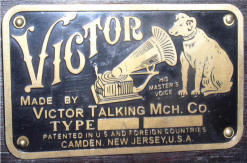
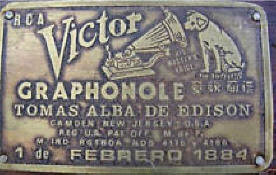
Nipper on Steroids
(left) A Chinese Reproduction Dataplate from a Fake Victrola. Poor
Nipper is suffering from "muscle bulge" syndrome. Note that the model "type"
and serial number areas have been left blank, allowing the seller to stamp
any information they wish. Mystery plate (right)
A
reproduction plate from Mexico made by someone who has been sampling too
much tequila. Both Victor and Edison brands are represented on this plate,
along with the meaningless term "Graphonole" and a pointless 1884 date. RCA
is also mentioned just to make it more confusing.
RESTORED PHONOGRAPHS.
A more problematic and
common issue is not a forgery at all, but more of a misrepresentation.
Original machines in good condition are almost always worth more money than a
restored one, even if the restoration was done correctly. What we mean by
"restored" is that the original finish was removed and re-done using modern
materials. In most instances, collectors do NOT consider the completion
of necessary mechanical repairs to be classified as a "restoration", whereas, any process which
strips-off the original varnish and stain and/or replaces the veneer is considered to be a restoration.
Many sellers on EBay and elsewhere are marketing machines as being "original"
when they have obviously been restored. In some instances, the owner may be
completely unaware of the situation. We often recieve appraisal requests where
the owner swears that 'this Victrola is just like when grandpa bought it
brand-new', but it was obviously restored somewhere along the way, perhaps many
decades ago.
Please be aware that there is nothing wrong with buying or selling a restored
machine...ANY restored machine...as long as the buyer is aware that it was
restored. For a machine that is showing severe wear or damage, a restoration is
often necessary to make the appearance acceptable. A correct (e.g. authentic) restoration, using proper
finishing materials and
techniques, can result in a machine that looks like new, and which will maintain
a reasonable
amount of its original value. On the other hand, phonographs that have been restored
incorrectly, (typically by using polyurethane or other modern
products) may look very nice, but will have very little value. Poorly restored
phonographs are becoming more and more common on the market.
Once it has been restored (well or poorly), it can never become original
again. Dishonest (or clueless) sellers
will often misrepresent a restoration, with hopes of fooling the
buyer into believing that it is original, and thus securing a much higher price.
Obvious indicators of a restoration
can include:
-
Poor color matching between the under lid or inside
areas and the outside of the machine cabinet.
If the "under-lid" colors are significantly different than the exterior cabinet colors, than
that's a possible indicator of a restoration, although it is common for
exterior portions of an original cabinet to have faded over time and
exposure. See pictures below. If you notice that the area immediately
surrounding the "Victrola" decal under the lid is darker than the rest of
the under-lid area, that is a certain sign of a not-so-hot restoration where
they masked-off the decal during stripping to protect it, and refinished the rest.
-
Dust specs or blobs,
especially in corners or crevices. It's somebody's basement refinish job,
most likely a pretty bad one. Poorly fitting parts. Doors, lids and other items should fit snugly and
operate smoothly.
-
The presence of dings, scratches or
gouges which match the cabinet color. When someone damages the veneer on a
phonograph, the resulting injury will often reveal the original (unstained)
veneer color. For example, if you scratch a dark-red mahogany machine, the
resulting "injury" will often appear off-white or grey due to the fact that
the surface finish was removed. Of course, the use of furniture touch-up
products can blend-in the correct color, but if you notice a lot of dings
and zings all over the machine, most of which have been finished-over, then
you are looking at a restored phonograph. Professional restorers will use
filler products to repair damage prior to applying finish coats.
-
Runs or drips.
Victor's quality control was fantastic. We've seen a few originals with small
runs that got by the Q/A inspector, but they are few and far between. If a
machine has runs, or an unevenly applied finish coat, it's likely a refinish
job. Poor application of finish materials can also result in a "wavy"
appearance.
-
"Too good to be true". It is the
extremely rare 100 year-old phonograph that appears completely 'as
new'. We have seen some incredible originals, and they can be worth a lot of
money. But in most
instances, if the machine has a perfect mirror-smooth finish, bright
gleaming hardware and absolutely no signs of wear or use, than it has quite
likely been restored.
See
the
GETTING STARTED section for more information
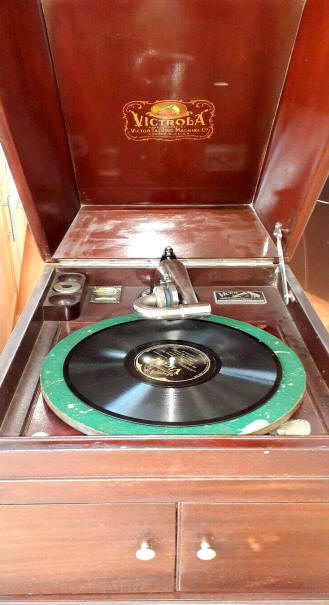
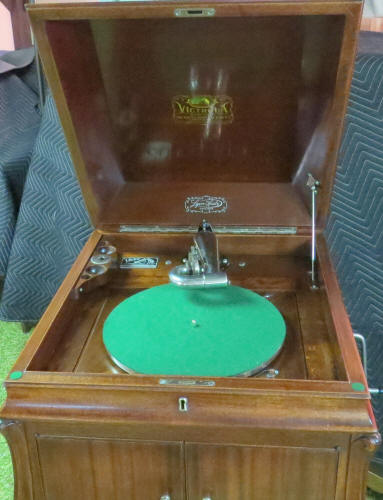
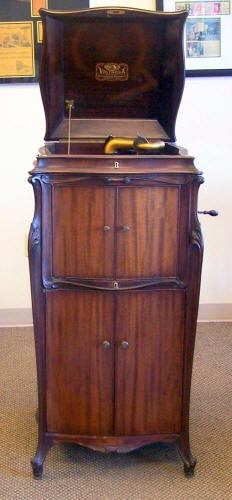
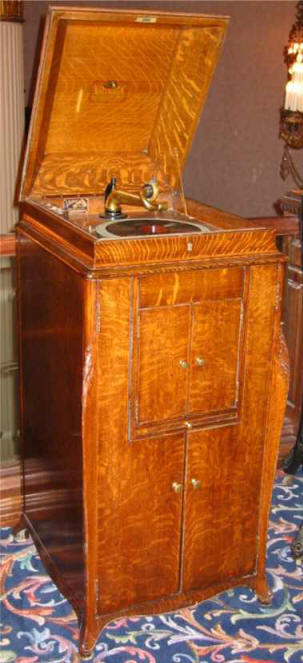
Has it been it restored?
Victrola Far-Left: The
uner-lid area is deep red and glossy, but the exterior of the cabinet is
faded and dull, and shows some minor damage. This is an original machine,
but is not in 'excellent' condition. The outside of the cabinet has faded
due to heat and/or humidty over the years. This Victrola originally had a
deep glossy appearance everywhere when new.
Victrola Left-Center: The
under-lid area is dark brown and very glossy, and while the exterior cabinet
is also brown, it has a different shading and is not nearly as glossy. Given the fact that
the external cabinet finish is glass-smooth and shows absolutely no wear, this
machine certainly was an amateur restoration. Many restorers have trouble matching
the original wood
color, and most want to leave the under-lid area in original
condition to preserve the decal. Professional restorers would match the
colors correctly. Victrola Right-Center:
The
under-lid area is glossy and dark. The cabinet is not at all glossy and shows a
far different coloring, but does not appear to be age-faded. Also, the trim
pieces on the sides are darker than the doors. Had the cabinet been
faded from age, the surrounding trim pieces would have faded at an equal
rate.
This example has been poorly restored, and the machine has been ruined from a collector's standpoint.
Victrola Far-Right:
This machine is an excellent original. The
under-lid and exterior matches perfectly in color and gloss. A professional
restoration would also have this type of appearance. This machine would be
classified in the "Top 5%" of surviving Victrolas.
PLEASE CLOSE THIS PAGE TO RETURN TO FAQ's or
RETURN TO HOME PAGE
VIA BUTTON ON TOP LEFT

 Some
of the reproductions can look pretty impressive (picture on left); others
are artificially "aged" to look old and can be quite convincing. When the
builder uses components (e.g. cabinets and/or horns) from a actual antique
phonograph, and assembles them using newer motors and hardware parts, it can
be difficult for the non-expert buyer to determine authenticity.
Reproduction or "fake antique" machines have a nominal value of about
$100.00 at resale today, mostly as decorations or movie props. In most
cases, repair services and motor rebuilders won't touch them, as the parts
are often impossible to find, and are often "jury-rigged" together to make
the motor functional. So it it quits working, you are probably out of luck.
Some
of the reproductions can look pretty impressive (picture on left); others
are artificially "aged" to look old and can be quite convincing. When the
builder uses components (e.g. cabinets and/or horns) from a actual antique
phonograph, and assembles them using newer motors and hardware parts, it can
be difficult for the non-expert buyer to determine authenticity.
Reproduction or "fake antique" machines have a nominal value of about
$100.00 at resale today, mostly as decorations or movie props. In most
cases, repair services and motor rebuilders won't touch them, as the parts
are often impossible to find, and are often "jury-rigged" together to make
the motor functional. So it it quits working, you are probably out of luck.





